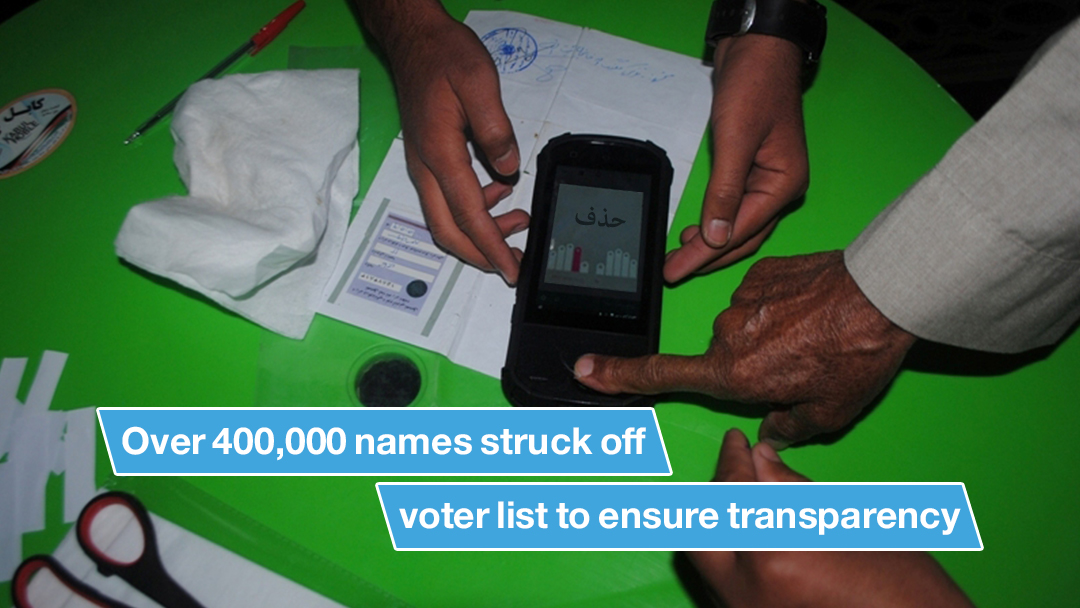Over 400,000 names struck off voter list to ensure transparency
KABUL (Pajhwok): The Independent Election Commission (IEC) says 427,000 doubtful names were removed in late July this year from the voter list to ensure the transparency of the presidential election.
The review was done following the 2018 Wolesi Jirga elections as part of a process of reexamining registration books and combining data sources, then screening for duplicates or fake Tazkera numbers.
Rejecting claims that voters from a certain part of the country or ethnic group had been struck off the list, the IEC said the process of removing suspicious names was nation-wide.
Zabihullah Sadaat, acting spokesman for the commission, said the election body had removed 427,000 voters from the list in two phases before the presidential vote. The process was not confined to one place or ethnic community.
He said individuals removed from the voter list held fake identity cards, did not meet the eligibility criterion or produced multiple Tazkeras.
He added: “We dispatched voter lists to the National Statistics and Information Authority, which said 27,000 ID cards did not exist in its database and they were removed.”
Habibur Rahman Nang, head of the IEC Secretariat, said some lists they had inherited from previous commissioners had problems, but the new list was error-free.
“Only individuals who registered with fake or dual ID cards have been deprived of the voting right,” he insisted.
Roena Shahabi, spokesperson for National Statistics and Information Authority (NSIA), also rejected the allegation that names of voters from a particular ethnic community had been excised from the list. There was no evidence to support the claim, she said.
She added the IEC had formally requested NSIA to identify fake, fraudulent and doubtful ID documents. They discharged their duty in line with the law, the official continued.
Shahabi explained: “Tazkeras having flaws were identified by the IEC as suspicious. The NSIA formally informed the poll panel that 27,000 Tazkeras had problems and the IEC can take any decision on them in line with its legal authority.”
Pajhwok tried to obtain formal letters exchanged between IEC and NSIA regarding transparency in voter lists but was unable to do so.
Pajhwok also sent the two institutions a special form to get the required information but both refused to cooperate on the issue.
The election monitoring organizations initially said they welcomed the scrutiny of the voter list to ensure transparency. But later on, they found negligence had been committed in this regard.
Yousuf Rashid, the Free and Fair Election Foundation of Afghanistan (FEFA) head, told Pajhwok that before the presidential election, a number of politicians welcomed the IEC decision to discard more than 400,000 voters.
He said their agents monitored the presidential election in different areas and the removal of such huge number of voters was not related to ethnicity, zone or language.
He said, “We, as an observer body, told the commission to prepare a list after correcting mistakes but our request was not supported. We noted that names of some people existed in the list, had stickers and they cast their votes in the Wolesi Jirga election, but their names were not in the biometric system on the presidential election day.”
Mohammad Naeem Ayubzada, head of the Transparent Election Foundation of Afghanistan (TEFA), said the IEC had committed negligence in preparing the voter filtration list and failed to prepare a transparent list.
Qutbuddin Roidar, an Independent Electoral Complaints Commission (IECC) member, said 417 complaints had been registered regarding missing names of voters in biometric system and another 792 complaints were about missing names from voter lists.
He said eight complaints had also been registered with them about no arrival of the voter lists to polling stations.
Ahmad Nasim, a resident of 5th municipality district of Kabul, said that he registered his name at the Ismail Hassanzai high school polling station for 2018 Wolesi Jirga election but he could not vote because his name was missing from the biometric system.
“I took a second voter card to participate in the presidential election, but my name was missing in biometric system and I did not vote,” he said.
Mohammad Hassan, a resident of 4th police district of Kabul, said that he had registered at Haji Mohammad Daud Mosque polling station but his name was not among voters on the Election Day.
Abdul Latif Pedram, a presidential candidate criticized deleting people’s names from voters lists and claimed their information showed NSIA employees worked in favor of specific electoral teams and removed names from voter lists.
Number of voters in 2018 Wolesi Jirga election:
The voter registration for 2018 elections was fresh and it was a paper-based process using books and each book had 100 pages and each page has six voter records. These books have been designated for male or female polling centers.
In this process, about 9,463,555 voters existed on the lists, but after scanning and transferring data from the books to the database, 563,614 records (voters) were removed based on the following seven categories.
In these categories: “1) 140,906 votes were used with torn ID cards, 2) 157,142 were duplicate ID cards, 3) 101,746 cards were without date of birth, 4) 160,693 were under age voters, 5) 403 has no Tazkera information, 6) 1,878 ID cards were registered in books which had been lost and 7) 846 voters were counted of polling centers which had been closed on the election day.
These records were identified and removed using database scripts that had no reference to geography or ethnicity and only data was scrutinized. This left a total of 8,899,941 eligible voters on the list for 2018.
Number of voters in 2019 presidential election:
After the 2018 Wolesi Jirga elections, the IEC had time to conduct a close scrutiny of the data which had been produced under tight time constraints. The commission discovered books that had not been scanned and some pages that had been missing.
The IEC also performed a new search on exact duplicate and spoiled IDs, which flagged 428,901 records for deletion. Again, this was done solely on the basis of the data on the voter record, without reference to geography or ethnicity.
After cleaning up and adding the votes to the data system, a total of 5,936,465 male voters and 3,167,187 female voters totaling 9,103,652 votes were left.
The IEC also had a list of 26,846 records from National Statistics and Information Authority (NSIA) that purportedly contained particulars of voters who had fake Tazkeras. The data in the NSIA list lacked sticker number data field so it was difficult to do a direct match to the database.
The IEC was only able to match 205 records based on available data, and only 181 of these were active voter records in the database. These 181 records were removed.
Ahead of the presidential ballot, the IEC conducted voter registration supporting process and about 329,312 new voters were registered.
The election body also launched this supporting voter registration process in southern Ghazni province, in which a total of 244,209 people were registered as voters.
The number of voters reached 9,665,745 across the country after the IEC added Ghazni votes. During the 2019 presidential election, approximately 2.7 million voters participated; of these numbers, the IEC announced 1,787,000 biometric-based votes thus far.
The presidential ballot was conducted on September 28. The preliminary results were expected to be announced on October 19 but the IEC announced a delay instead. The IEC said that the results will be declared after identification of clean votes.

Azizullah Hamdard
Hits: 11902
Agreement reached on procedure for peace talks
KABUL (Pajhwok): An agreement between the Afghan government and the Taliban negotiating te…



